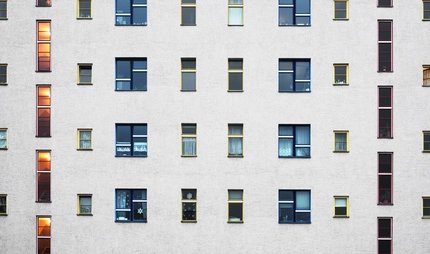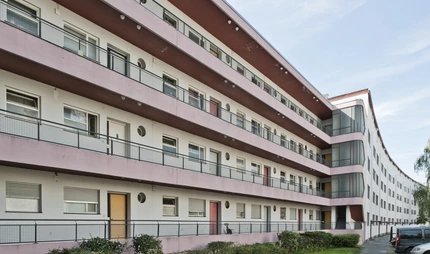
Gustav Adolf Church
An icon of New Objectivity
Anyone who steps inside will feel its incredible spatial effect: Otto Bartning's Gustav
Adolf Church in Charlottenburg-Nord.
The Gustav Adolf Church was Otto Bartning’s masterpiece – an icon of New Objectivity that never lost its appeal. The architect combined functionalism with warmth by using light and space in an ingenious way.
New church buildings are somewhat rare today, unlike a hundred years ago. At that time, new parishes were emerging everywhere: many people moved to the still - independent city of Charlottenburg in search of work. The Gustav Adolf parish was formed in 1915 – a new evangelical community in the north of the city.
There was a long way to go until their own church could be built. Although the new parish quickly gained 21,000 members, there was hardly any money, so they had to hold their church services in a school, private apartments, and restaurants.
It was only with the support of the Berlin Synod Association that they were able to construct their own building. The parish held an architecture competition but weren’t convinced by the quality of the submissions. In 1929, they transferred their building contract to the distinguished master church builder Otto Bartning, whose Steel Church made of steel and glass had caused a furore at an exhibition in Cologne the year before.
Strong impression
The building site in Charlottenburg was located on a corner plot at the intersection of Brahe - and Herschelstrasse. Although the conditions were actually unfavourable, Bartning turned them to his advantage: the street corner became the starting point for the entire building, which was further accentuated by a slender, high bell tower. From here, the church fanned outwards into a total of five naves. He positioned the church hall and the convent at the sides.
Girders made of reinforced concrete formed the basis of the building, which was able to accommodate a total of 1,150 visitors. The architect chose yellow - brown clinker brick for the facing. But above all, the steel construction allowed for the incorporation of large window areas. The side windows were decorated in different hues and filled the church with warm light, irrespective of the weather or time of day. The grey - blue windows behind the altar took on a different role: they didn’t let any light into the room, but opened up the spacious room without dazzling visitors.
Purposeful spatial effect
Bartning created a sloping floor between the entrance and the chancel. When people approached the chancel, they appeared to get smaller as the elevated altar and a huge cross loomed before them. This was intended to give believers a sense of humility.
There was no choir, as the sermon was to take centre stage. This not only applied to the visual impact of the sermon but also the acoustics: Bartning’s construction ontrolled the sound wave dispersion, so there was no reverberation. An expressionist detail could be found in the church organ, with its striking serrated silhouette.
Rescuing the masterpiece
The Gustav Adolf Church was one of the last building projects during the Weimar Republic period. The Nazis used it for their own purposes: in 1934, the pro - Nazi German Christians organised its inauguration in the presence of Ludwig Müller, the Nazi Reich Bishop of the Evangelical Church. The church was severely damaged by several bombs in the Second World War and the parish was unable to find any money for repairs during the post - war period. They even contemplated pulling the church down. But the architect saved his work.
The Nazis had denounced Otto Bartning’s work as “cultural Bolshevism” but he gained recognition again after the war. He became president of the Association of German
Architects in 1950. Prior to this he had already succeeded in setting up an emergency church programme and, with the help of American sponsors, was able to repair churches.
And this included the Gustav Adolf Church. The Neues Bauen (New Building) techniques proved to be useful. The reinforced concrete foundation was preserved in spite of the
bombing and the emergency church programme from 1949 to 1951 ensured a simplified reconstruction. At the end of the decade, the historical monument was restored to its previous condition. The bright windows with their warm colours have since regained their original glory. Only the expressionist church organ was irrevocably destroyed by the war.
Our tips for the Gustav Adolf Church
You can visit Schloss Charlottenburg, which lies in the immediate vicinity. You also have the opportunity to discover other Berlin Modernism attractions by public transport. Take the bus M27 from Jungfernheide S+U-Bahn station towards Pankow S+U-Bahn station. Get off at the Turmstrasse/Beuss elstrasse stop and walk to Huttenstrasse: there you will find the AEG turbine factory, the first building of modern industrial architecture. Not to be missed is another sacred Modernist building: the Kaiser Wilhelm Memorial Church. To get there, take the Ringbahn (circular line) to Westhafen and then take the U-Bahn line 9 towards Rathaus Steglitz. From the Zoologischer Garten S+U-Bahn station it is just a short walk to the Kaiser Wilhelm Memorial Church on Breitscheidplatz.
Practical information from visitBerlin
You can get to the Gustav Adolf Church by taking the Ringbahn (circular line) or U-Bahn line 7 to Jungfernheide S+U-Bahn station. To explore the city by public transport, we
recommend the Berlin WelcomeCard.


